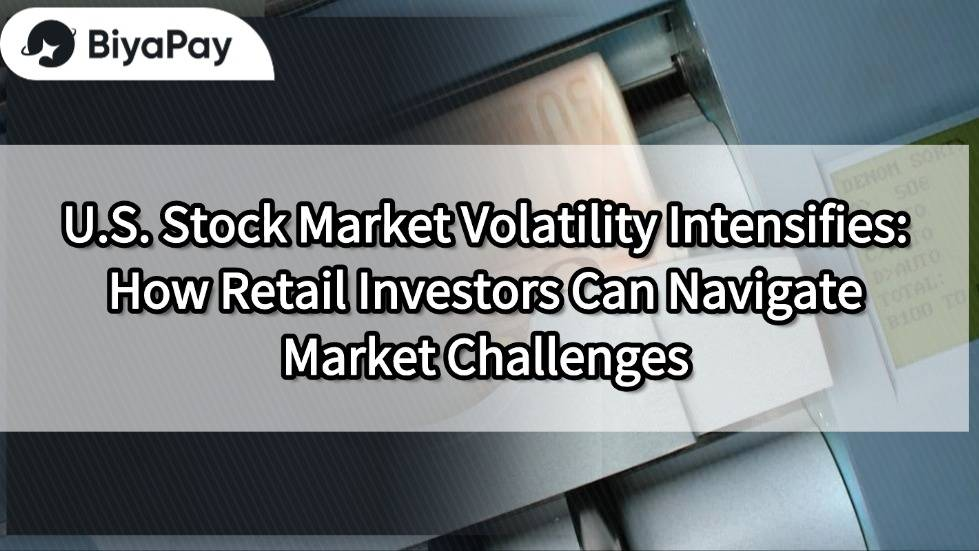- EasyCard
- Trade
- Help
- Announcement
- Academy
- SWIFT Code
- Iban Number
- Referral
- Customer Service
- Blog
- Creator
U.S. Stock Market Volatility Intensifies: How Retail Investors Can Navigate Market Challenges

Image Source: pexels
The volatility of the U.S. stock market is intensifying, directly impacting retail investors’ confidence and decision-making ability. According to Deutsche Bank statistics, since 2010, large fund managers’ stock positions have only been lower than current levels 23% of the time. This indicates that, despite retail investors driving market rebounds, the cautious stance of institutional investors may put pressure on market trends. The Chief Investment Officer of Truist Advisory Services also noted that institutional investors are more focused on risk than returns, further exacerbating challenges for retail investors. In such a market environment, you need to master the U.S. stock retail investment guide and develop effective strategies to reduce risks and achieve stable returns.
Main Reasons for Intensified Market Volatility
Impact of Global Economic and Policy Changes
Global economic and policy changes have profoundly impacted the volatility of the U.S. stock market. You need to understand how these factors drive market trends to better address challenges.
- Monetary Policy: Changes in the Federal Reserve’s monetary policy directly affect U.S. stock market performance. For example, the Federal Reserve raised interest rates by 425 basis points in 2022, putting pressure on market valuations. In contrast, the U.S. stock market continued to strengthen in 2023 due to economic resilience and technological advancements.
- Earnings and Valuation: Stock prices are typically driven by earnings per share (EPS), while valuations are influenced by interest rates and corporate growth potential. The S&P 500 price-to-earnings ratio was positively correlated with U.S. Treasury yields before the 2008 financial crisis.
- Cyclical Sectors: Market interest in cyclical exposures has risen, with significant fund inflows into non-essential consumer goods sectors. This trend provides partial support for the market.
The following are the specific impacts of global economic and policy changes on U.S. stock market volatility:
| Impact Factor | Description |
|---|---|
| Earnings | Stock price performance is primarily driven by earnings (EPS). |
| Valuation | U.S. stock valuations are typically influenced by interest rates and corporate growth potential. |
| Monetary Policy | Changes in the Federal Reserve’s monetary policy are closely related to U.S. stock market performance. |
By focusing on these key indicators, you can assess potential market risks and opportunities.
Role of Retail Investor Behavior in Driving Market Volatility
Retail investor behavior plays a significant role in market volatility. You may have noticed that retail investors’ concentrated investments and high-risk strategies often lead to sharp market price fluctuations.
- Concentrated Investments: Retail investors tend to invest in highly volatile stocks, such as those related to artificial intelligence and virtual assets. This behavior increases market uncertainty.
- Chasing Short-Term Profits: Many retail investors suffer significant losses due to chasing short-term gains. Data from 2024 indicates that high-risk investment strategies can lead to severe consequences.
- Global Participation: Korean retail investors account for only 0.2% of the U.S. stock market’s total value, but their investment preferences significantly impact the market. For example, they tend to invest in high-volatility stocks, further exacerbating market fluctuations.
Retail investor behavior resembles the tense experience of “Squid Game.” You need to avoid emotional decision-making and develop sound investment strategies to minimize the impact of market volatility on your investments.
U.S. Stock Retail Investment Guide: Key Strategies to Address Market Challenges

Image Source: unsplash
Define Investment Goals and Plans
In a volatile market, defining clear investment goals is your first step to success. Investment goals can include long-term wealth accumulation, short-term gains, or retirement planning. You need to create a clear plan based on your financial situation and risk tolerance.
- Set Specific Goals: For example, aim to achieve an average annual portfolio growth rate of 8% over the next five years.
- Execute in Phases: Break down goals into short-term, medium-term, and long-term tasks, ensuring each step is measurable and adjustable.
- Periodic Evaluation: Review portfolio performance quarterly to ensure goals align with market changes.
By defining clear goals, you can avoid blindly following market trends and reduce anxiety caused by market volatility.
Use Risk Management Tools
Risk management tools are essential weapons for addressing market challenges. These tools help you quantify risks, optimize your portfolio, and reduce potential losses. Below are several common risk management methods:
- Real-Time Data Updates and Analysis: Use real-time market data to stay informed about dynamic changes and optimize investment decisions.
- Flexible Risk Control Mechanisms: Set risk tolerance levels for your portfolio and adjust asset allocations promptly.
- Robust Report Generation: Generate detailed risk analysis reports to identify potential issues and take action.
- Risk Assessment Techniques: Use tools like Value-at-Risk (VaR) models, Monte Carlo simulations, and stress tests to quantify risks and develop response strategies.
For example, Monte Carlo simulations can predict portfolio performance under different market conditions. This method allows you to identify high-risk assets in advance and take action. By using these tools, you can better protect your investments and reduce losses caused by market volatility.
Stay Rational and Calm
In a volatile market, staying calm is key to success. Emotional decisions often lead to investment failures. You need to cultivate rational thinking and avoid being swayed by short-term market fluctuations.
- Clear Risk Awareness: Recognize the risks of high-leverage trading and assess your own risk tolerance.
- Strict Investment Strategy: Set stop-loss points and profit targets to ensure risks are manageable.
- Reasonable Leverage Control: Choose appropriate leverage ratios to avoid excessive risk.
- Diversified Investments to Reduce Risk: Diversify investments to minimize the impact of individual stocks or sectors.
- Periodic Portfolio Evaluation: Review fundamentals and market trends to adjust strategies promptly.
For example, many successful investors stick to their strategies during significant market fluctuations, avoiding panic-driven mistakes. By regularly reviewing your investment goals and strategies, you can maintain a calm mindset and focus on long-term value investing.
Focus on Long-Term Value Investing
Long-term value investing is a strategy that can help you achieve stable returns in a volatile market. By focusing on a company’s fundamentals and long-term growth potential, you can avoid emotional decisions driven by short-term market fluctuations. Below are key points to help you understand the advantages of long-term value investing and its practical applications.
- Reduce Trading Frequency: Frequent trading increases transaction costs and may lead to losses due to short-term market fluctuations. Long-term holding of high-quality assets allows you to benefit from compound growth.
- Focus on Company Fundamentals: Select companies with stable profitability, healthy financial conditions, and long-term growth potential. By thoroughly analyzing financial reports and industry trends, you can more accurately assess long-term value.
- Maintain Investment Discipline: Set clear investment goals and strictly execute plans. Avoid frequent portfolio adjustments due to market sentiment fluctuations.
According to a report by Tsinghua University’s Fintech Research Institute and Ant Wealth, long-term investors often achieve higher returns. Below are some related data points:
- Nearly 60% of respondents held a fund for more than one year.
- 41.84% of individual investors hold investments for 1 to 3 years, and 16.61% hold for more than 3 years.
- Over 78% of respondents believe that excellent stock selection, scientific allocation, and long-term holding are healthy investment behaviors that enhance returns.
- 53% of investors believe that simultaneously adopting these three behaviors is crucial for achieving good returns.
- From early 2019 to mid-2024, the public fund industry earned a cumulative profit of $2,232.6 billion for investors, with equity and hybrid funds generating modest profits over this 5.5-year period.
These data points indicate that long-term value investing not only helps you mitigate the risks of short-term volatility but also enables steady wealth growth over time.
Tip: When selecting investment targets, you can refer to the suggestions in the “U.S. Stock Retail Investment Guide” and combine them with your risk tolerance and investment goals to develop a suitable long-term investment strategy.
By adhering to long-term value investing, you can better navigate market volatility and avoid missing out on long-term growth opportunities of high-quality assets due to short-term fluctuations.
Key Challenges for Retail Investors
Negative Impact of Emotional Decision-Making on Investments
In a volatile market, emotional decision-making is one of the main challenges for retail investors. You may feel anxious due to short-term market fluctuations, leading to poor decisions like chasing rallies or selling at lows. This behavior not only reduces your investment returns but may also result in significant losses.
According to research on the Chinese A-share market, retail investors often make emotional decisions due to a lack of financial knowledge, leading to suboptimal investment outcomes. Below are specific data points:
| Challenge Type | Description |
|---|---|
| Emotional Decision-Making | Retail investors tend to chase rallies and sell at lows during market volatility, leading to reduced returns. |
| Lack of Financial Knowledge | Lack of deep market understanding makes it difficult to develop scientific investment strategies. |
| Advantages of Quantitative Stock Selection | Quantitative stock selection strategies can reduce emotional interference, improving objectivity and success rates. |
You can reduce emotional interference in decision-making by learning quantitative stock selection strategies or using professional investment tools. For example, setting clear stop-loss points and profit targets can help you stay calm during market volatility and avoid panic-driven mistakes.
Tip: During the investment process, maintaining rationality and discipline is key. Focus on long-term goals rather than being led by short-term fluctuations.
Potential Risks of High-Risk Investment Strategies
High-risk investment strategies pose another major challenge, especially for inexperienced retail investors. You may pursue high returns by adopting aggressive investment approaches, but these strategies often carry significant risks.
Below are potential risks of high-risk investment strategies:
- High-risk strategies may lead to greater capital losses.
- Lack of market analysis skills may make it difficult to accurately assess the potential risks of investment targets.
- Overly aggressive mindsets and frequent market timing may lead to investment failures.
For example, many retail investors tend to invest in highly volatile stocks, such as those related to artificial intelligence or virtual assets. While these may offer short-term gains, they also significantly increase portfolio volatility and risk. Without sufficient market analysis skills, you are likely to suffer significant losses during market corrections.
To mitigate the risks of high-risk strategies, you can refer to the suggestions in the “U.S. Stock Retail Investment Guide” and opt for more prudent investment approaches. For example, diversifying investments and reducing leverage ratios can effectively minimize the impact of individual assets or sectors on your portfolio. Additionally, regularly assessing your portfolio’s risk levels can help you adjust strategies in a timely manner, avoiding unnecessary losses due to market volatility.
Suggestion: When choosing investment strategies, develop a plan suited to your risk tolerance and financial goals. Avoid blindly pursuing high returns while ignoring potential risks.
Case Studies and Practical Tips

Image Source: pexels
Recent Market Hotspots Analysis: Tesla and AI Sector
Tesla and the artificial intelligence (AI) sector have recently become market focal points. You may have noticed that stocks in these areas are highly volatile but also offer significant investment opportunities. Below is a brief analysis of these two hotspots:
- Tesla: Tesla’s stock price experienced significant volatility in 2023. Despite sustained growth in electric vehicle sales, the market has divergent views on its valuation. Tesla continues to expand in autonomous driving technology and energy storage, providing potential for future growth. If you are interested in Tesla, it’s recommended to focus on studying its financial statements and technological innovation progress.
- AI Sector: AI-related stocks gained significant attention in 2023 due to breakthroughs in generative AI technology. Companies like NVIDIA and Microsoft have attracted substantial investor interest due to their leadership in the AI field. Be cautious, as these stocks’ valuations may be inflated due to market sentiment. Therefore, in-depth analysis of companies’ fundamentals and technological advantages is crucial.
Tip: When investing in these hotspots, avoid chasing rallies or selling at lows. You can reduce risk through diversified investments while focusing on companies’ long-term growth potential.
Portfolio Recommendations and Risk Control Methods
Building a robust investment portfolio is an effective way to address market volatility. Below are some statistically validated success cases that may provide inspiration:
- Zixuan Guo used the Bayes prediction method to analyze stock investment risks, reducing uncertainty in returns and adopting diversified capital allocation to lower investment risks.
- Hua Song and Yang Wang, based on Markowitz’s portfolio theory, used mean-variance analysis to select optimal portfolios, providing effective asset allocation strategies.
- Ke Lu conducted empirical analysis of mean-variance models and utility maximization models to help investors determine optimal portfolios.
- Yifan Li and others developed dynamic portfolio models under the context of the COVID-19 pandemic, studying the impact of investor behavior on investment decisions and providing efficient portfolio selection.
You can learn the following from these cases:
- Diversified Investments: Allocate capital across different asset classes to reduce the risk of individual assets.
- Dynamic Adjustments: Regularly optimize your portfolio based on market changes to ensure asset allocation aligns with the current market environment.
- Quantitative Analysis: Use tools like mean-variance models to scientifically assess portfolio risks and returns.
Suggestion: In practice, you can combine your risk tolerance and financial goals to choose suitable investment strategies. By learning from these success cases, you can better control risks and achieve steady growth in investment returns.
In a volatile market, you need to master effective coping strategies. Defining investment goals, using risk management tools, staying calm, and focusing on long-term value investing can help you reduce risks and achieve stable returns.
Independent thinking is key. Avoid blindly following market sentiment; instead, develop a suitable investment plan through in-depth research and rational analysis. Long-term investing is also crucial. By holding high-quality assets, you can better withstand short-term volatility and achieve steady wealth growth.
Tip: Stick to rational decision-making and avoid emotional operations. Market volatility is inevitable, but through scientific methods and firm conviction, you can become a successful investor.
FAQ
1. How can retail investors cope with significant market volatility?
You can reduce risk through diversified investments, avoiding concentrating funds in a single asset. Additionally, setting clear stop-loss points and profit targets helps you stay calm during market volatility. Focus on long-term value investing to minimize the impact of short-term fluctuations on your decisions.
2. Is frequent portfolio adjustment necessary?
Frequent adjustments are not necessary. Frequent trading increases costs and may lead to poor decisions driven by market sentiment. You can periodically (e.g., quarterly) evaluate your portfolio and make appropriate adjustments based on market changes and personal goals to ensure reasonable asset allocation.
3. How to choose suitable risk management tools?
When selecting tools, prioritize methods like Value-at-Risk (VaR) models and Monte Carlo simulations. These tools help quantify risks and develop response strategies. Combining real-time data analysis optimizes investment decisions and reduces potential losses.
4. What are the main advantages of long-term value investing?
Long-term value investing reduces transaction costs and avoids emotional decisions driven by short-term fluctuations. By holding high-quality assets, you can benefit from compound growth while mitigating risks from short-term market volatility.
5. How can retail investors avoid emotional decision-making?
You can reduce emotional interference by setting clear investment goals and maintaining discipline. For example, establish stop-loss points and profit targets to avoid chasing rallies or selling at lows. Using quantitative stock selection strategies or professional tools can enhance decision objectivity and success rates.
Heightened volatility in the U.S. stock market demands that retail investors adapt flexibly to risks while seizing opportunities for stable returns. BiyaPay offers a seamless financial solution, enabling trading in U.S. and Hong Kong stocks without offshore accounts, allowing you to participate in the market cost-effectively, whether capturing short-term volatility through high-frequency trading or investing in resilient assets for the long term.
It supports USD, HKD, and 30+ fiat and digital currencies with real-time exchange rate transparency, ensuring clear transactions and aiding risk management. With remittance fees as low as 0.5% across 190+ countries, it facilitates flexible cross-border fund allocation to navigate market uncertainty. A flexible 5.48% annualized yield savings product with no lock-in period optimizes capital use during volatile markets, boosting return potential. Sign up for BiyaPay today to combine disciplined investment strategies with BiyaPay’s low-cost tools for a flexible, secure investment experience!
*This article is provided for general information purposes and does not constitute legal, tax or other professional advice from BiyaPay or its subsidiaries and its affiliates, and it is not intended as a substitute for obtaining advice from a financial advisor or any other professional.
We make no representations, warranties or warranties, express or implied, as to the accuracy, completeness or timeliness of the contents of this publication.




Contact Us
Company and Team
BiyaPay Products
Customer Services
BIYA GLOBAL LLC is a licensed entity registered with the U.S. Securities and Exchange Commission (SEC No.: 802-127417); a certified member of the Financial Industry Regulatory Authority (FINRA) (Central Registration Depository CRD No.: 325027); regulated by the Financial Industry Regulatory Authority (FINRA) and the U.S. Securities and Exchange Commission (SEC).
BIYA GLOBAL LLC is registered with the Financial Crimes Enforcement Network (FinCEN), an agency under the U.S. Department of the Treasury, as a Money Services Business (MSB), with registration number 31000218637349, and regulated by the Financial Crimes Enforcement Network (FinCEN).
BIYA GLOBAL LIMITED is a registered Financial Service Provider (FSP) in New Zealand, with registration number FSP1007221, and is also a registered member of the Financial Services Complaints Limited (FSCL), an independent dispute resolution scheme in New Zealand.




















